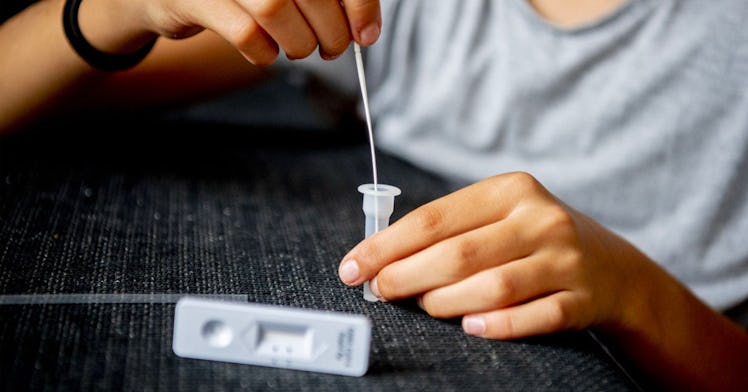The CDC Now Recommends At-Home COVID Testing Before Indoor Gatherings. There’s Just One Problem
At-home COVID tests are, for now, an out-of-pocket expense that is not cheap.

Going to an indoor party? What about an indoor conference over a long weekend? What about a big dinner with the cousins over a grandma’s house on Christmas? You might want to consider doing a rapid at-home test for COVID when attending an indoor gathering, according to the latest guidance from the Center for Disease Control and Prevention (CDC). But there’s a small snag for most families – these tests can get expensive.
The CDC recently updated its advice, reports New York Magazine, and now offers more information on different situations in which you might want to swab your own nose. The agency now suggests doing an at-home test if you have symptoms or have been exposed to someone with COVID-19, but also if you’re planning on “gathering indoors with others,” regardless of vaccination status or if you are symptomatic.
The tests are not a perfect measure to see if you have the virus, but they can offer a little more risk reduction in terms of planning for indoor gatherings. (Indoor gatherings are, of course, riskier than outdoor gatherings because the coronavirus can spread effectively via the air – making fresh, flowing air important.) The CDC recommends taking the test as close as you can before the gathering to maximize the risk reduction potential, and note that some tests say you should do it twice, over a period of a few days.
New York reports that these kinds of tests are commonly available, including at local pharmacies, and that the White House has stated that health insurance plans will have to reimburse people for them starting early next year. It’s important to note that “early next year” is not now, and people will be traveling and gathering — probably indoors! — more than normal in just the coming weeks.
What matters is these tests are not always cheap. And not everyone has insurance, either, when insurance companies do kick in next year. For example, Walgreens currently lists three different brands of at-home COVID-19 antigen tests at $23.99 per kit – each kit containing two tests, and all tests recommending two tests per person over the course of a few days. And Target has one for $31.99 and another for $15.79. Out-of-pocket, that’s no small fee, especially around Christmas.
Prices and availability likely vary from city to city and store to store. But let’s say you find tests for about $20 per kit, and you want to do an at-home test for a family of four – that’s $80-$100 right off the bat. While going to a testing site for a PCR or rapid test is a little more time-consuming, those tests are often free or entirely covered by insurance. And some states have far fewer options for PCR or rapid tests outside of the house than others.
Making health insurance companies reimburse people for rapid test purchases could probably help. But there are still dozens of days between now and 2022, and tons of indoor gatherings for Christmas Eve, Christmas Day, and New Year’s Eve — alongside other family gatherings — planned for holiday-goers in those days.
There is, of course, a simpler and more affordable way for families to follow this public health guidance. But the White House just needs to make it happen. This week, White House Press Secretary Jen Psaki faced criticism for her response to a question about at-home rapid tests.
Psaki was listing some of the administration’s recent work on these tests, including the provision to get health insurers to cover them. According to The Intercept, NPR’s Mara Liasson then queried: “That’s kind of complicated though. Why not just make them free and give them out and have them available everywhere?”
To which, Psaki responded, somewhat mockingly, “Should we just send one to every American?”
“Maybe. I’m just asking you — there are other countries —,” Liasson said.
“Then what — then what happens if you — if every American has one test? How much does that cost, and then what happens after that?” Psaki responded.
The point Psaki seems to miss here is that, yes, it can be expensive – for Americans who want to get tested. But the cost is beside the point.
There’s a reason that testing outside of the home has been mostly free, and that the vaccines are free: it helps keep everyone safe during the pandemic and is part and parcel of a robust public health response that puts people over profits. If the CDC suggests that everyone steps up and gets at-home tested throughout the holidays and before they gather indoors, those tests ought to be covered by the government too. The Intercept notes that rapid tests are free in the United Kingdom, like pretty much all their healthcare.
Yesterday, the press secretary tweeted that the administration planned to send millions of tests out to “locations like health centers and community sites.” That’s a good start. But at least for now, if you can afford it, you might want to think about getting tested before a big indoor gathering – COVID is still here, and you’re going to want to start 2022 off on a good note.
This article was originally published on